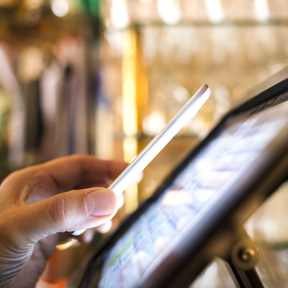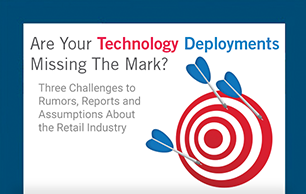Waiting in the checkout line at the store has long been a quintessential part of the typical shopping experience. Yet for new generations of consumers, the “checkout line” may be as unfamiliar as the video cassette recorder, as traditional cash-register based point of sale (POS) becomes a relic of the past. Once considered a feature of only the most progressive, high-tech retailers, streamlined checkout – whether mobile, contactless or grab-and-go - is becoming the norm for retailers across the board. Juniper Research predicts that more than half of global transactions and one-third of U.S. transactions will be contactless by 2022.
 In the coming weeks, we’ll explore why retailers are focusing so much attention and investment on reinventing the point of sale, examine some of the most prevalent technologies supporting streamlined checkout, and understand the impact on customers.
In the coming weeks, we’ll explore why retailers are focusing so much attention and investment on reinventing the point of sale, examine some of the most prevalent technologies supporting streamlined checkout, and understand the impact on customers.
The many faces of streamlined checkout
The evolution of the “checkout” process, defined here as completing a retail transaction by paying for goods and services purchased, was reinvented with the introduction of e-commerce. The shift from an actual physical shopping cart to a virtual shopping cart, while in many ways comparable, did introduce some benefits including reduced wait time, the convenience of 24/7/365 purchasing, and easy last-minute changes to the items in the shopping cart.
The proliferation of “phygital” stores (combination of online and physical stores) has retailers experimenting with ways to completely eliminate checkout as we know it. The idea is to make it seamless, error-free and instant. Yet there are several different models emerging, each fueled by different advantages, technologies and benefits to the consumer. Here are some of the top emerging options for the new point of sale.
Tap-and-go credit cards– The next evolution in “contactless” checkout, tap-and-go credit card payments are arriving. Chip-embedded cards merely require tapping rather than sliding or inserting, accelerating the payment process. The optimal applications are those where relatively small value purchases are taking place and customers are on the move. Widespread adoption is occurring in transportation venues like subways, bus lines, as well as convenience stores and coffee shops. For larger purchases, credit card companies are requiring a PIN to avoid theft.
Mobile checkout– Once considered the domain of high-tech, savvy retailers like Apple stores, mobile checkout is taking retail by storm. Retailers from major department stores to outdoor retail kiosks are outfitted with payment systems enabled on mobile devices. The benefits include empowering employees to handle the entire retail transaction: from greeting and engaging the customer, through the education and selection assistance process, all the way through payment. This makes the shopping experience easier, more streamlined and more pleasant for the customer and also reduces expenses associated with having cash registers complete with POS software and a staff of cashiers to man those registers.
“Forget it” checkout –Apps like Uber ask the consumer to load their credit card information into the app when they first download and register. They need not think about payment again. Any time they use the app, that credit card is automatically charged. This is the ultimate in convenience, but may not be the optimal solution when consumers want to check pricing, ensure they received discounts, and possibly dispute or return merchandise.
Self-scan checkout– Some retailers are developing their own custom apps that allow customers to sign on upon entering the store, scan items and place them into their cart and simply walk out of the store. The app then records all items scanned and presents the customer with a bill at the end of their shopping trip, allowing them to select which payment option they wish to use. This method gives customers the flexibility to choose the payment method they desire and also ties nicely into promotions, couponing and other store-specific loyalty programs. However, self-scan checkout can present challenges to the retailer because they rely on the honesty of the customer to ensure they scan all of their items.
Grab-and-go– Pioneered in Amazon Go stores, this literally allows shoppers to grab items and, using a combination of IoT, AI and camera technologies, automatically charges the customer for those items. Also knows as “frictionless” checkout, grab-and-go is in many ways considered the ‘ultimate’ in streamlined checkout. Technology-intensive, this is an expensive option for retailer and the ROI results are still pending.
All of these methods offer simplified, streamlined checkout to customers and operational benefits. As retailers continue to explore how they will evolve the point of sale in their stores, there are many considerations to take into account. From here, we’ll explore some of the technology options available and considerations for a successful implementation.




